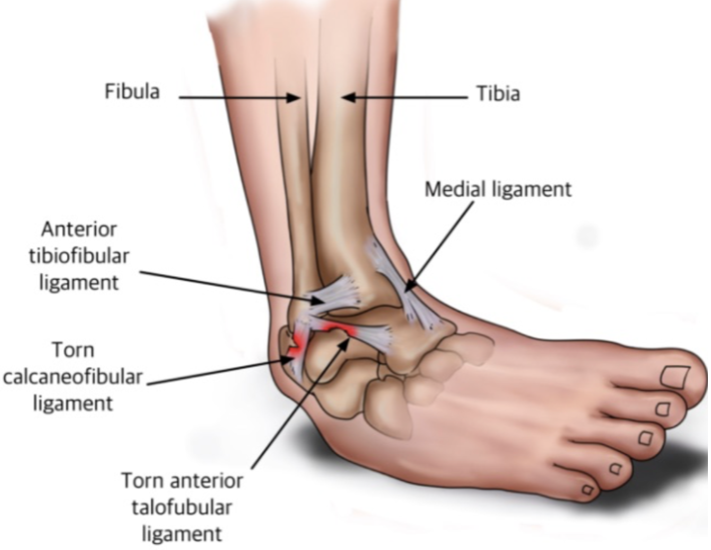Anatomy of the Ankle
The ankle joint is formed by the connection of the tibia and fibula (the bones of the lower leg) with the talus (the ankle bone). The stability of the ankle is maintained by a network of ligaments, particularly the lateral ligaments on the outside of the ankle. These ligaments provide crucial support to the joint, ensuring proper alignment during movement and preventing excessive sideways motion. The most important ligaments involved are the anterior talofibular ligament (ATFL), calcaneofibular ligament (CFL), and the posterior talofibular ligament (PTFL).
inimizing the risk of long-term joint damage and arthritis.
What is Ankle Instability?
Ankle instability occurs when the ligaments that support the ankle become weakened or damaged, often following repeated ankle sprains. This condition leads to the ankle “giving way” during everyday activities or sports, resulting in a loss of balance and recurrent injuries. Patients with ankle instability may experience joint pain, swelling, and inflammation, particularly after episodes of instability.
Ankle instability is commonly classified into two types:
Chronic Ankle Instability: Occurs after repeated ankle sprains and results in persistent feelings of instability and a tendency for the ankle to roll outward.
Functional Ankle Instability: Involves a sensation of giving way without any clear ligament damage, often due to impaired balance, muscle weakness, or proprioception issues.

What Happens in Ankle Instability?
In cases of ankle instability, the lateral ligaments of the ankle become overstretched or torn, leading to a loss of their stabilizing function. This creates a cycle where the ankle is more prone to further injury, with each episode weakening the ligaments further. Over time, the instability can cause damage to the cartilage and joint surface, leading to the formation of bone spurs (osteophytes) and, in severe cases, arthritis.
Patients with ankle instability often describe:
- Intermittent sharp pain during episodes of the ankle giving way.
- Chronic dull aching during physical activity.
- Swelling, tenderness, and a feeling of weakness in the ankle.
- Difficulty with sports or activities requiring balance and lateral movement.
How is Ankle Instability Diagnosed?
The diagnosis of ankle instability typically involves a clinical examination and patient history. The key components of diagnosis include:
- Physical Examination: The physician will test for ligament laxity by manipulating the ankle to assess its range of motion and stability.
- Stress Tests: Special tests, such as the anterior drawer test, may be performed to evaluate the integrity of the ankle ligaments.
- Imaging: X-rays, MRI, or ultrasound may be used to assess ligament damage, bone spurs, or joint surface injuries.
How is Ankle Instability Treated?
Treatment for ankle instability focuses on reducing pain, restoring ligament function, and preventing further injury. Both conservative and surgical options may be considered, depending on the severity of the instability and the patient’s activity level.
Non-Surgical Treatment
- Rest, Ice, Compression, and Elevation (RICE): Initially, RICE is recommended to manage acute symptoms and reduce inflammation. Anti-inflammatory medications can also help relieve pain and swelling.
- Physiotherapy: Once the acute injury has settled, physiotherapy is critical for regaining strength, balance, and proprioception (joint position sense). This helps restore normal ankle function and reduce the risk of further instability.
- Bracing: For individuals with ongoing instability, an ankle brace may be recommended to provide additional support during sports or daily activities.
For most patients, these conservative measures are successful in managing symptoms and restoring ankle stability.
Surgical Treatment
In cases where non-surgical treatments fail (approximately 10-15% of patients), surgery may be indicated to restore ligament function and address any underlying joint damage. The goals of surgery are to repair or reconstruct the damaged ligaments, restore stability, and prevent further degeneration of the joint.
Ligament Reconstruction: The most common procedure involves restoring the ligaments to their original anatomical position. This may be done using either the patient’s own tissue or an artificial ligament to reinforce the repair. Most reconstructions are performed as open procedures, though they can be combined with arthroscopy to address other issues like bone spurs or cartilage injuries.
Post-Surgical Care: After surgery, patients typically need to stay off the ankle for 7 to 10 days, followed by a period of rehabilitation while wearing an ankle brace for 4 to 6 weeks. Gradual return to physical activity is essential to prevent re-injury.
Prevention of Ankle Instability
Preventing ankle instability involves maintaining strong and flexible muscles around the ankle, engaging in balance training, and using proper footwear during sports activities. Strengthening exercises that target the muscles of the lower leg, as well as proprioception training, can help prevent future sprains. For athletes or those with a history of ankle injuries, ankle braces or taping may provide additional support during high-risk activities.
Summary
Ankle instability is a common condition following repeated ankle sprains, leading to weakened ligaments and a tendency for the ankle to give way. Patients with ankle instability often experience pain, swelling, and chronic discomfort, which can impact daily activities and sports performance. While non-surgical treatments such as physiotherapy and bracing are effective in most cases, surgery may be required for individuals with persistent symptoms. Preventive measures and early intervention are crucial for m

